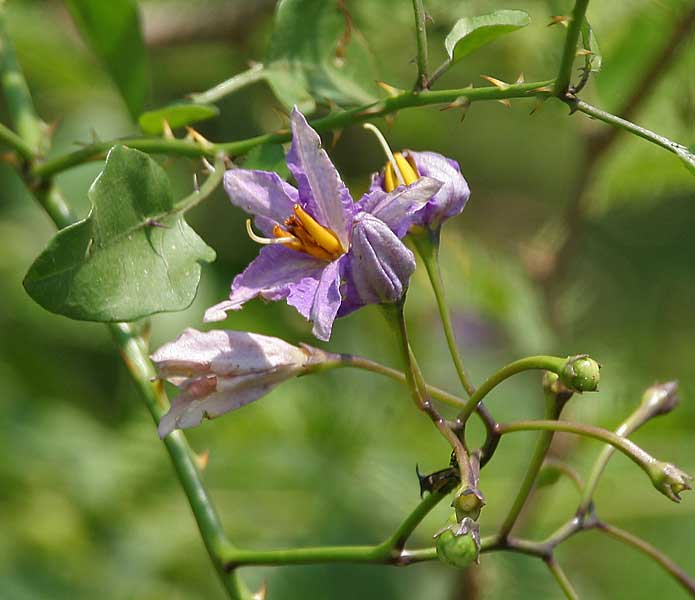
Solanum wendlandii (*)
Classification System: APG IV
Superregnum: Eukaryota
Regnum: Plantae
Cladus: Angiosperms
Cladus: Eudicots
Cladus: Core eudicots
Cladus: Asterids
Cladus: Lamiids
Ordo: Solanales
Familia: Solanaceae
Subfamilia: Solanoideae
Tribus: Solaneae
Genus: Solanum
Sectio: S. sect. Aculeigerum
Species: Solanum wendlandii
Name
Solanum wendlandii Hook.f. (1887:tab. 6914)
Type: Edmonds (2012) cites a K specimen as "Holotype", this is improper as there is no confirmation that the material in question is original, or the two sheets (K000695647 and K000695646) are a single specimen as opposed to a gathering. Clark & al. (2015:1127) designate K000195647 as neotype. This is also incorrect (Art 9.8 and 9.4 of the ICN) as original material still exist in the form of plate 6914, which ought to have been designated as lectotype
Type locality: Cultivated at Kew in the Water Lily House, from seeds "sent in 1882 by Dr. Wendland, Director of the Royal Gardens at Herrenhausen, Hanover, with the information that it is a native of the cold regions of Costa Rica" (Hooker, 1887).
Synonyms
(After Clark & al, 2015)
Solanum tlacotalpense Sessé & Moc. (1894:52)
Lectotype: M. Sessé & J. Mociño s.n. (MA-604681, MA, F neg. 48334)
Isolectotypes: MA (MA-604680, F neg. 48333; MA-604682, F neg. 48335)
Designated by Knapp (2008:20).
Type location: Mexico. Veracruz: "ad fluviorum Tuxtlentium" [on the banks of Río Tuxtla, presumably near San Andrés Tuxtla, (Clark & al., 2015:1127)].
Solanum mazatenangense Coult. & Donn. Sm. (1904:421)
Lectotype: J. Donnell Smith 2669 (US-1324650, US, barcode US00840548)
Isolectotypes: US (US-1324649, US-258628), F (F-267128), GH (GH0077513), K (K000195648, K000195649), NY (NY00139006)
Designated by Clark & al. (2015:1127).
Type location: Guatemala. Retalhuleu: San Felipe, 2050 ft, Apr 1892.
Solanum unguis-cati Standley (1929:320)
Holotype: P. Standley 56726 (F-581029, F)
Type location: Honduras. Atlántida: Lancetilla Valley, near Tela, 50 m ["20–600" on label], 9 Mar 1928 ["Dec. 6, 1927–Mar. 20, 1928" on label].
Corrected date and elevation from Clark & al. (2015:1127)
References
Clark, J.L., Nee, M., Bohs, L. & Knapp, S. 2015. A Revision of Solanum Section Aculeigerum (the Solanum wendlandii Group, Solanaceae). Systematic Botany 40(4): 1102–1136. DOI: 10.1600/036364415X690148 Reference page.
Donnell Smith, J. (1904). Undescribed Plants from Guatemala and Other Central American Republics. XXVI. Bot. Gaz. 37(6):417–423. JSTOR. DOI: 10.1086/328506.
Edmonds, J.M. (2012) Flora of Tropical East Africa: Solanaceae. Ed. Beentje, H. Royal Botanic Gardens, Kew. ISBN 978-1-84246-395-6. Reference page.
Hooker, J.D. (1887) Solanum wendlandii, Lambert's Night-shade. Curtis's Bot. Mag. 113:tab. 6914.
Knapp, S. (2008) Typification of Solanum (Solanaceae) species described by Sessé and Mociño. Anales J. Bot. Madrid 65:7–23. DOI: 10.3989/ajbm.2008.v65.i1.243.
Sessé, M. & J. M. Mociño. (1894) Flora Mexicana, 2nd ed. XXII-240p. Ignatius Escalante, Mexico City.
Standley, P.C. 1929. Studies of American plants – II. Publ. Field Columbian Mus., Bot. Ser. 4:301–345.
USDA, ARS, Germplasm Resources Information Network. Solanum wendlandii in the Germplasm Resources Information Network (GRIN), U.S. Department of Agriculture Agricultural Research Service. Accessed: 09-Oct-10.
Solanaceae Source
Vernacular names
svenska: Klätterskatta
Solanum wendlandii, the giant potato creeper, potato vine, Costa Rican nightshade, divorce vine, or paradise flower, is a species of flowering plant in the family Solanaceae. It is native to Mexico, Central America, and northwest South America, and has been widely introduced as an ornamental to other tropical locales, including the Caribbean, Africa, Nepal, Java, and many islands in the Indian and Pacific Oceans.[1][2] A robust vine reaching 15 ft (4.6 m), its long-lasting dark purple flowers eventually fade to white.[3]
References
"Solanum wendlandii Hook.f." Plants of the World Online. Royal Botanic Gardens, Kew. Retrieved 8 December 2021.
"Solanum wendlandii giant potato creeper". The Royal Horticultural Society. 2021. Retrieved 8 December 2021.
"Giant Potato Creeper". Flowers of India. 2021. Retrieved 8 December 2021.
Retrieved from "http://en.wikipedia.org/"
All text is available under the terms of the GNU Free Documentation License

